

Test: the Canon EOS R8 mirrorless full-frame camera as a high-end microscope camera
Launched in 2023, the Canon EOS R8 is a reasonably budget-friendly mirrorless system camera (priced at around EUR 1,400 as of June 2025) that offers impressive performance and features despite its compact, lightweight body.
The camera has a large, high-quality 24-megapixel full-frame sensor that is exceptionally light sensitive and features a wide dynamic range. With our LM microscope adapters, the EOS R8 seamlessly integrates with any microscope setup. We offer adapter solutions with integrated optics for both the phototube (C-mount) and the eyepiece tube of the microscope.
The EOS R8 borrows many of its state-of-the art technology features from the much more expensive sister models R3 and R6II. The main differences are the more basic body (cheaper materials without weather sealing) and the lack of a sensor shift image stabiliser. However, when using the R8 as a microscope camera, these differences are not only negligible but actually a plus: omitting the image stabiliser in the camera body facilitates better heat management. Due to the solid mechanical connection, the heat transfer from the sensor to the camera body is more efficient, keeping the sensor cooler and thus minimising image noise.
In our tests, we’ve recorded an impressive dynamic range that is on par with the current professional models from Canon. Echoing our findings, the popular online magazine DXO has noted similar standout dynamic capabilities.
This fact, combined with the moderate pixel count of 24 megapixels, makes the camera a cost-effective specialist for low-light imaging tasks, such as fluorescence microscopy.
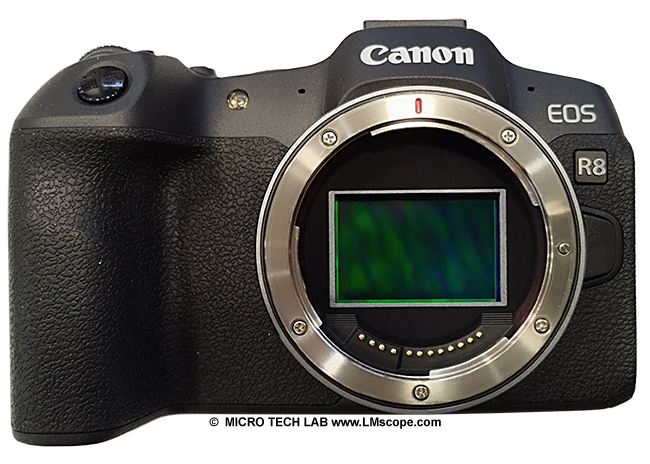
Main features of the Canon EOS R8:
- 24 megapixel full-frame CMOS sensor 36 mm x 24 mm
- Electronic shutter with speeds between 1/16,000 and 30 seconds
- Continuous shooting at up to 6 frames per second at maximum resolution (up to 1,000 photos in JPEG, RAW or C-RAW)
- Exposure bracketing up to 7 shots, HDR function
- ISO range 100 to 51,200 (expandable to 50 to 102,400)
- No in-body image stabilisation
- Video recording in 4K RAW at 60 fps, Full HD at 180 fps; up to 120 minutes
- USB 3.2 type C for data transfer and charging
- HDMI micro out terminal (type D) to display the live image on an external monitor
- Wi-Fi (wireless LAN) and Bluetooth capabilities
- 4K time-lapse recording at 30 fps
- SD memory card (SDHC, SDXC, UHS I, UHS II)
- Vari-angle touchscreen LCD monitor: 7.5 cm (3.0 inch) display, 1.62 million pixels
- Lens mount: Canon R-mount
- Compatible with LP-E17 battery pack
Demo photo: Body of a fly with protruding hairs. Taken with a ZEISS Stemi 508 Greenough stereo microscope, LM microscope adapter and the Canon EOS R8
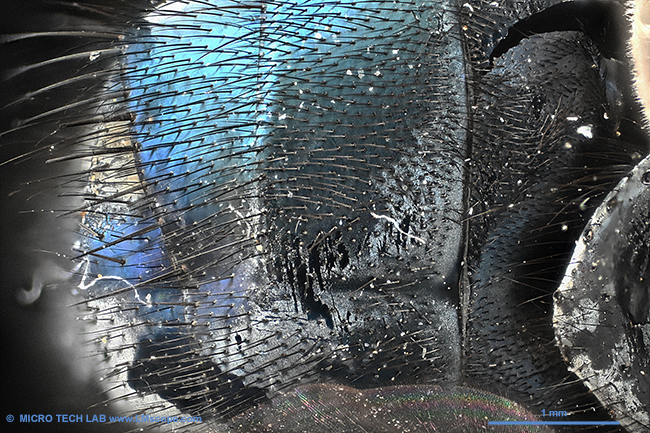
Weighing in at about 461 g (including battery and memory card), the EOS R8, nicknamed the “little sister” of the R6 II, is Canon’s lightest full-frame mirrorless camera to date. Its slimmed-down, lightweight body offers advantages for stationary use in a laboratory or studio setting, and also for attaching it to a microscope, The lightweight design is particularly beneficial when working with lower-priced microscopes that don’t have a dedicated phototube, because it allows attaching the camera to the eyepiece tube of the microscope without compromising on stability and performance. To attach the camera, one eyepiece is removed and the camera, together with the adapter unit, is inserted into the tube where the eyepiece was.
The easiest way, however, is to use one of our LM DSLR / DSLM microscope adapters and attach the camera to the phototube of the microscope (provided it has one). Our standard portfolio includes adapter solutions for standard C-mount connections and adapters that can be directly fitted to the basic phototube of most microscopes. Upon request, we also manufacture customised adapter solutions.
Example configuration: Leica laboratory microscope, phototube with C-mount connection, LM Widefield Plus microscope adapter and Canon EOS R8
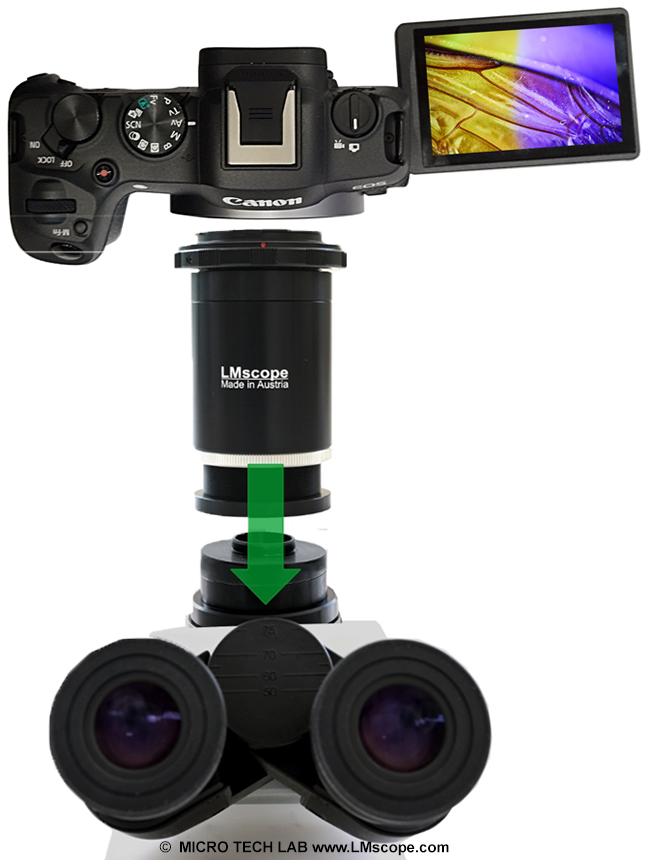
The 7.5 cm, vari-angle touchscreen display with 1,620,000 pixels is a handy feature for microscopy applications. It allows users to adjust the camera settings and check the focus.
Demo photo: Insect wing. Taken with a SteREO Discovery V12 microscope, LM microscope adapter and the Canon EOS R8
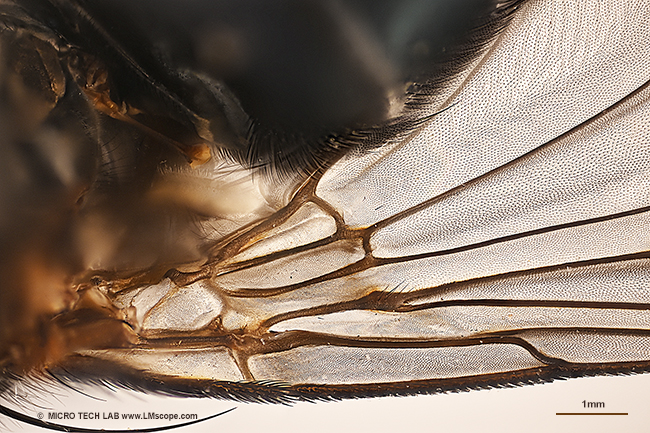
Compared to conventional C-mount microscope cameras, which typically feature smaller image sensors (usually 1/2 inch), the EOS R8’s 24.2-megapixel full-frame CMOS sensor is a decisive advantage when it comes to microscopy applications.
The combination of a large sensor and a mid-range megapixel count results in a larger area per pixel. This allows more photons to be collected and processed by each pixel in the same amount of time.
Light sensitivity, as expressed by the ISO number, can be set from 100 to 102,400 in native mode and can be expanded from 50 to 204,800 if needed.
Generally, it is advisable to use the lowest possible ISO settings to ensure that the image sensor operates at peak efficiency, thereby yielding the highest dynamic range. For static low-light applications such as fluorescence microscopy, the exposure time can be set to up to 30 seconds.
If you are looking for a camera exclusively for fluorescence microscopy, the Sony Alpha 7S (II and III) with 12 megapixels is a superior choice, offering enhanced performance for such specialised applications.
The EOS R8 is also a highly capable video camera. It has a 4K/60p video mode where oversampling the 6K sensor data is used for 4K recording, which significantly enhances the video quality.
Full HD video can be recorded at up to 180 frames per second, enabling time-lapse and up to 6x slow-motion footage. The high frame rate is an advantage for documenting dynamic processes in microscopy, such as cell movements, chemical reactions, or the rapid motion of microorganisms.
When using the electronic shutter, the shortest exposure time of the EOS R8 is 1/16,000 second. In electronic shutter mode, the camera is capable of high-speed burst shooting at an incredible rate of up to 40 frames per second. With differently exposed series of images, multiple HDR modes enable the camera to capture more dynamic range.
The camera’s USB-C port ensures fast data transfer and battery charging, provided the power source is strong enough to provide sufficient power for charging.
The EOS R8 also has USB video output, allowing it to be used as a webcam for streaming live content.
Side view of the camera with USB-C and HDMI ports
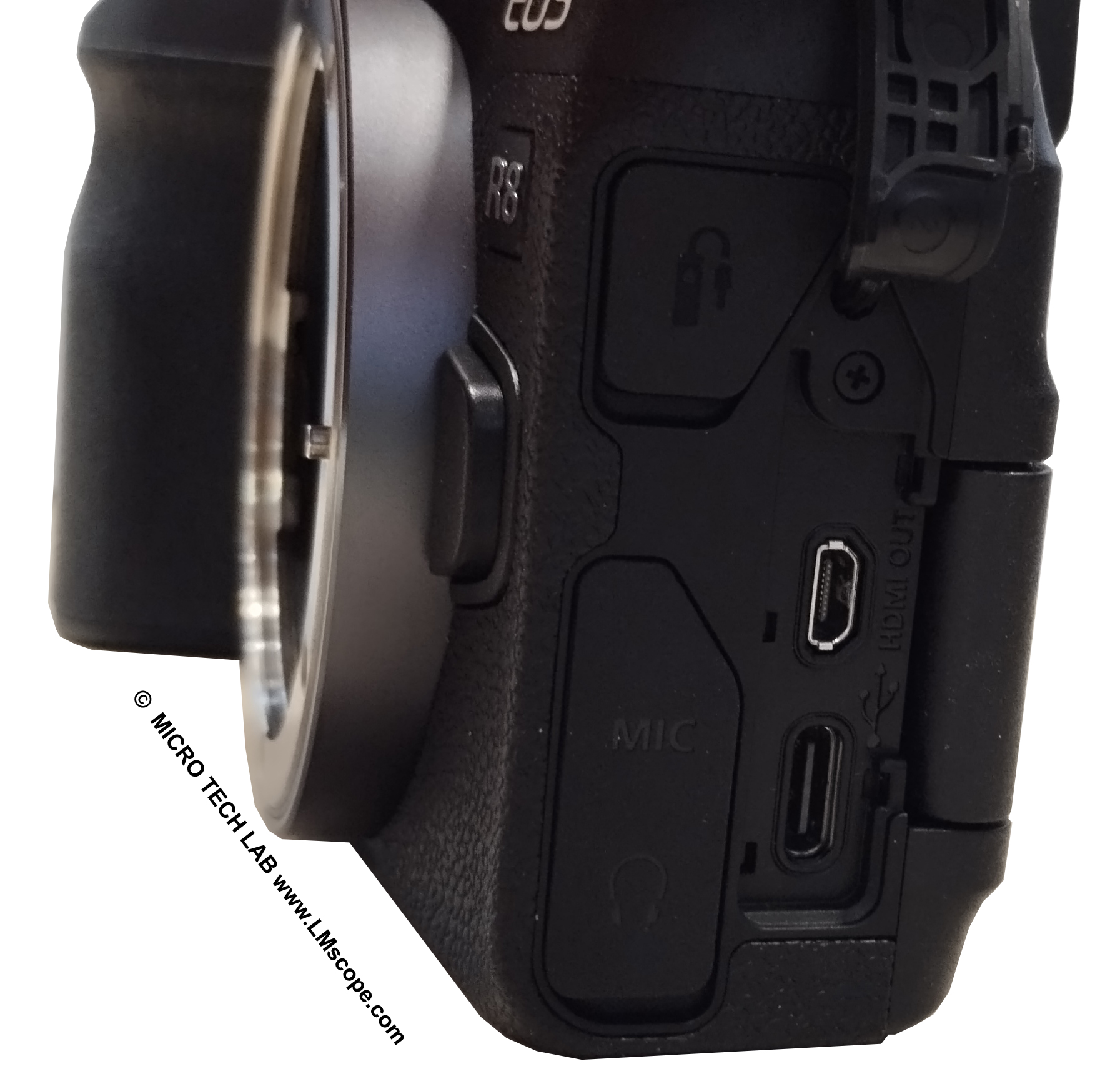
Networking capabilities are another key feature of the EOS R8, allowing for seamless camera control from a PC, tablet or smartphone to perform important tasks remotely, such as focussing the image in the Live View window. Canon’s EOS Utility software not only enables the configuration of camera settings and remote shooting, but also lets the user save the captured images directly to the PC or other external devices. This is best done through the USB-C interface, which also has a charging function, or wirelessly via Wi-Fi.
The camera has a HDMI micro out terminal, which can be used for connecting it to a large external monitor with an HDMI cable. This way, the camera’s live feed can be displayed at a larger size, for example when giving presentations.
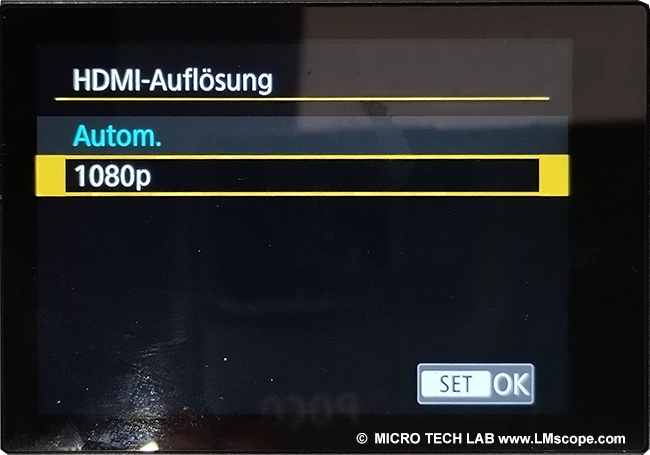
Conclusion: The EOS R8 features a high-quality sensor that delivers excellent photo and video quality. It is a great fit for microscopy applications and also offers a very good price-to-performance ratio, making it a compelling alternative to the less powerful performance of standard C-mount microscope cameras.
New LM Digital Adapter for: Canon EOS R3 / Canon EOS R6 Mark II / Canon EOS R8 / Canon EOS R5 II / Canon EOS R5 / Canon EOS R6 / Canon EOS R / Canon EOS Ra (Astro) / Canon EOS RP / Canon EOS R7 / Canon EOS R10 / Canon EOS 1D X Mark III / Canon EOS 1D X Mark II / Canon EOS R100 / Canon EOS 1D X / Canon EOS 90D / Canon EOS 5D Mark IV / Canon EOS 6D Mark II / Canon EOS M6 Mark II / Canon EOS 250D / Canon EOS 850D / Rebel T8i / Canon EOS 6D / Canon EOS M200 / Canon EOS 5DS R ( without low-pass filter) / Canon EOS 80D / Canon EOS M50 Mark II / Canon EOS 5DS / Canon EOS M50 / Canon EOS 70D / Canon EOS 200D / Canon EOS 800D / Rebel T7i / Canon EOS 77D / Canon EOS 5D Mark III / Canon EOS 60D / Canon EOS 750D / Rebel T6i / Canon EOS 760D / Rebel T6s / Canon EOS 5D Mark II / Canon EOS 1D Mark IV / Canon EOS 7D Mark II / Canon EOS 600D / Rebel T3i / Canon EOS 650D / Rebel T4i / Canon EOS 700D / Rebel T5i / Canon EOS 2000D / Rebel T7 / Canon EOS 7D / Canon EOS 550D / Rebel T2i / Kiss X4 Digital / Canon EOS 1300D / EOS Rebel T6 / Canon EOS 4000D / Canon EOS 100D / Canon EOS 50D / Canon EOS 1200D / EOS Rebel T5 / EOS Kiss X70 / Canon EOS 1100D / Rebel T3 /